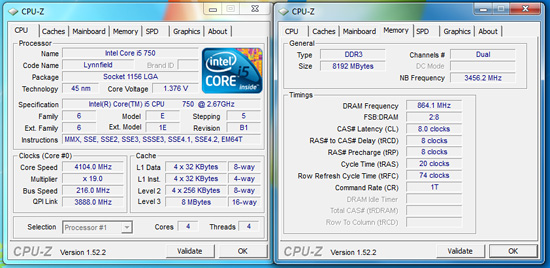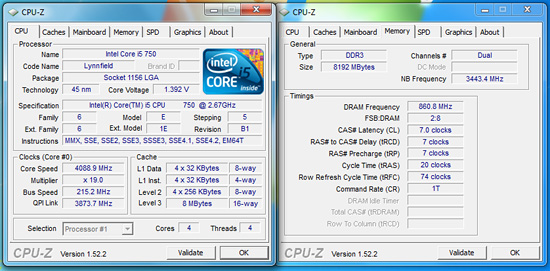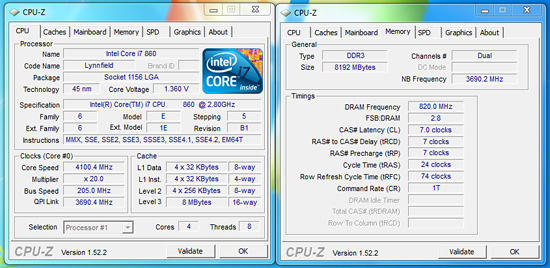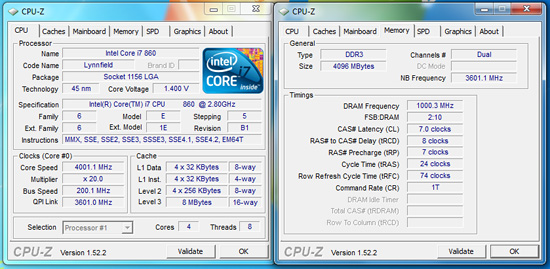Budget Micro-ATX P55 Faceoff: Gigabyte GA-P55M-UD2 and ASRock P55M Pro
by Gary Key on October 5, 2009 12:30 PM EST- Posted in
- Motherboards
Overclocking
If you are on a strict budget but still want a P55 motherboard with a full feature set that offers solid overclocking abilities, the ASRock P55M Pro is a very good choice.
Core i5/750 8GB Results

Our maximum stable overclock on air-cooling with the Core i5/750 resulted in a 4.1GHz clock speed at a respectable 216MHz Bclk with a variety of 8GB DDR3-2000+ kits. The primary voltages settings were 1.3625V VCore, 1.36V VTT, 1.80V PLL, and 1.64V VDimm. The VCore setting is deceiving. We had to run the board with Load Line Calibration (Vdrop off) enabled for stability. This was with setting the voltage manually to 1.3625V or with the Overdrive Offset enabled with +0.1625V.
This meant the VCore would rise to 1.384V~1.392V during load conditions. It was either this or run the processor at 1.425Vand accept Vdroop of 0.05V. Also, we had to relax memory timings to DDR3-1728 at 8-8-8-20 1T settings. VDimm would have to be increased to 1.71V (the next step from 1.64V) in order to run C7 settings on this board.


We could improve memory timings or speed with the Bclk set to 215 and dropping our CPU multiplier to 19, but that required a VCore increase to 1.375V as we left VTT at 1.36V along with enabling Vdrop in the BIOS. Memory had to be increased to 1.71V for C7 operation and PLL remained at 1.80V. We could run the memory at DDR3-2152 at 9-9-9-27 2T but VTT had to be increased to the next step at 1.42V and PLL to 1.94V. Performance was not measurably different from our 19x206 setting in application testing, but CPU temperatures were up 3C. Even though these settings passed our stability test suite, we just felt like the trade off in increased voltages was not worth some very minor memory performance gains.
Core i7/860 8GB Results

Our i7/860 fared better clocking wise than the i5/750, but we could not match the 21x205 speeds generated with the Gigabyte board without raising VCore to 1.425V. We ended up at a perfectly stable 20x205 setting resulting in a 4.1GHz clock speed with 8GB at DDR3-1740 at 7-7-7-24 1T timings. However, our voltage settings were lower due to the decreased clock/memory speeds.
VTT is set to 1.36V, PLL at 1.94V, VDimm at 1.64V, and VCore at 1.350V with the Overdrive Offset/VDrop enabled. Under load conditions VCore was +.015V~+.02V with Vdrop enabled and -.055V~-.06V with it disabled. Our Core i7/870 clocks matched these exactly.
Core i7/860 4GB DDR3-2400 Results

ASRock advertised DDR3-2400 speeds so we decided to verify their claim. Unfortunately, the board had serious problem running our OCZ DDR3-2400 Blade kit at 2400 with the stock 9-10-9-24 1T settings on 1.71V. We just could not dial in stability at that memory speed. We had to settle for DDR3-2000 7-8-7-24 1T timings at 1.64V. Of course, those memory speeds is more than fast enough for application usage and let’s face it, nobody will be buying this board thinking they are going to break world records.
Thoughts
The overclocking results are solid and certainly 4.1GHz speeds are fast enough for most. Let’s face it; if you have to have the best possible OC performance, then the Gigabyte UD2 board is simply better. We have no concerns recommending the ASRock board for 24/7 overclocking use. When it is overclocked, the board is very stable. As a bonus, it had no problems doing an S3 resume with the Bclk set to 215.
In regards to voltage regulation, ASRock follows Intel’s guidelines exactly. This has advantages as the processor is always running at specifications when it comes to Vdrop and Vdroop, but the disadvantage is that one has to really take time to tune the board to get the most out of it. The board was really designed to get you to about 90% of your component’s capabilities and that is it. Trying to tune another 5% performance improvement was possible, but very time consuming and frustrating to be honest.
In most cases I would not use the word frustrating, but compared to the Gigabyte UD2 board, that next five percent in tuning consumed about five times as much time on the ASRock board and we still did not match the speeds on the Gigabyte board. Granted, we are talking about numbers that look really good in screenshots and yes, application performance like encoding and file compression will show a small improvement. However, one has to ask if it is worth it.
The end story is that we would rather implement a practical overclock around 3.8GHz with the i7/860 or i5/750 at 1.275V than push to speeds around 4.1GHz~4.3GHz that require more expensive memory kits and cooling. In that context, the ASRock board is more than capable for most overclocking duties.
















55 Comments
View All Comments
goinginstyle - Monday, October 5, 2009 - link
I loved the review also and it showed a lot of work went into testing these boards. I just wonder when TA152H is going to ruin this thread but until then it nice to see constructive posts. I also wish the mobo guys would just drop the floppy and IDE ports when possible. It would free up board real estate and hopefully drop the cost a little more.papapapapapapapababy - Monday, October 5, 2009 - link
not touching any of this at least it has Socket 775 mounting holesusb3 @ pci3 @sata6 and im there.
Docket - Monday, October 5, 2009 - link
It is a shame that there are no Linux versions of the Gigabyte software reviewed here... oh well maybe some day in a distant future.mitt - Monday, October 5, 2009 - link
Hallelujah! DPC latency benchmark in AnandTech reviews!mathew7 - Monday, October 5, 2009 - link
When MB manufacturers are going to let go of PCI?I recently switched to Micro-ATX, and found I have a real problem of choosing a motherboard.
I'm looking at buying a PCIe X-Fi, but would like to use a dual-slotted video card. But I would like to keep my options open for a second card (I'm htinking about physics, not SLI/CF, so dual-slot cooling is not required). While the Gigabyte does not pass my requirements, the Asrock also has a problem: usage of a dual-slot-cooled card inhibits the usage of the PCIex1 slot.
I intend to switch to i5/P55 at the start of next year, so I'm watching closely.
Jaybus - Thursday, October 8, 2009 - link
That will be a slow transition. There are still a lot of PCI adapters being sold out there, especially for some specialty markets like scientific instrumentation that take time to transition to new interfaces due to cost and low volume. Nevertheless, the demise of PCI is starting to happen. For most people it's not a big deal, because they only need 1 or 2 PCIe x16 slots for graphics cards and will never use the rest of the slots anyway.MadMan007 - Monday, October 5, 2009 - link
Kind of funny but Intel is leading the pack in that specific area, their $200 (ugh) 'Extreme' DP55SB mATX P55 mobo has no PCI slots, also no PS/2, IDE or floppy. Maybe it's consistent since they ditched PS/2 and other legacy connectors on some boards a while back. No telling on the overclocking front but it is an 'extreme' board so it may have at elast some overclocking features. It has a couple of neat features actually, Bluetooth and Intel NIC.Jaybus - Thursday, October 8, 2009 - link
And uATX is a good platform to remove PCI from. Why not drop it from uATX? They can always leave it on ATX boards for a while for those who absolutely need PCI slots. I think other manufacturers will follow that path very soon.MadMan007 - Monday, October 5, 2009 - link
*bzzt* The only PCIe 2.0 lanes on a P55 platform are from the CPU. So look carefully at specs and double check with companies when they say their secondary slots, especially ones that aren't even 16x mechanical, are PCIe 2.0. The UD2's 4x electrical slot in particular is clearly not according to Gigabyte, the ASRock claims to be but I'm not sure how if all 16 CPU PCIe 2.0 lanes are used for the graphics slot. If they used a lane splitter to provide PCIe 2.0 lanes to the other slots it kind of defeats the purpose, and if so it would be good to check performance with those slots populated.MadMan007 - Monday, October 5, 2009 - link
To follow up on this, the comment was based on the first few paragraphs. I looked over Intel's manual for their 'extreme' mATX board for my post about it and Intel actually states their mobo has PCIe 2.0 lanes to the additional PCIe slots. Not surprising for the 8x slot I guess but it is for the 1x slots and it seems unlikely Intel would misquote specs.On a related note there is one thing I've not seen yet from any review and that is how PCIe lanes get assigned, mainly to the primary 16x slot, when populating a secondary PCIe slot with a 1x or 4x card. Do the lane splitter chips assign 8x lanes to a secondary slot which has a 1x or 4x card or what? Not a huge deal but it's a little thing that would be nice to know.